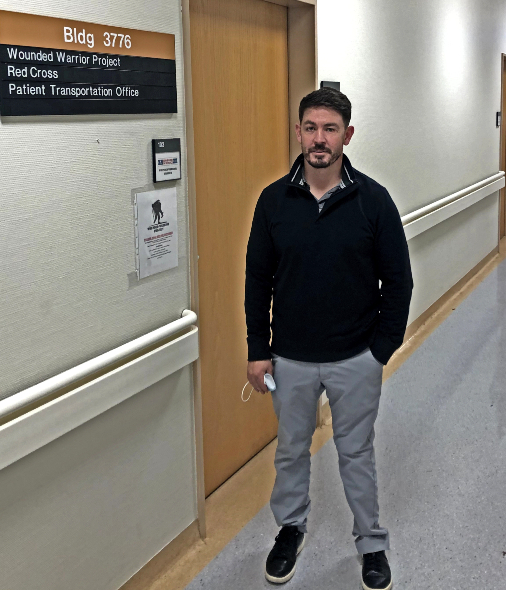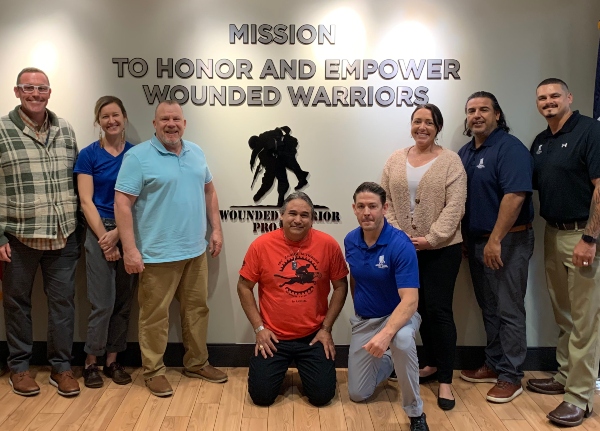A Letter to Landstuhl from a U.S. Marine: Thank You for Saving My Life

Marine Lance Cpl. Tim Horton was injured in combat in 2005 and evacuated to Landstuhl Regional Medical Center (LRMC) in Germany, Europe’s largest U.S. military hospital. Tim had the opportunity to travel back to Landstuhl as a Wounded Warrior Project® (WWP) employee with a group of fellow veterans and speak to groups of medical professionals and active-duty personnel. Onsite, he thanked them for the work they do every day to save lives, including his own.
By Tim Horton
As a combat-injured Marine, I didn’t really remember the days I spent in Landstuhl, where I was medically evacuated from Iraq with critical wounds. But I do know that the medical professionals at LRMC saved my life. They are the reason I made it home to tell my story.
In December 2022, I had the privilege of going back to Landstuhl. I was honored and humbled to return and gained a new appreciation for the tireless work LRMC staff do every day to save lives. I got to see the Intensive Care Unit, where I was once a patient. Although the clinicians who were there in 2005 have rotated out, the staff’s mission and dedication are the same. I proudly served as a United States Marine from October 2003 through June 2006. I was deployed in support of Operation Iraqi Freedom from September 2004 to February 2005. Our unit was part of the first elections in Iraq. I do believe we made a difference in the time we were there.
| About Landstuhl Regional Medical Center |
|
On Feb. 5, 2005, while on a mobile patrol, my Humvee was struck by a remotely detonated improvised explosive device. That day changed the course of my life as I aspired to serve 20 years or more. I wanted a fat stack of awards like Marine legends Chesty Puller and Carlos Hathcock.
The medevac report to my parents in Kansas said that I was seriously injured. I had shrapnel wounds to the leg, head, neck, face, arms, and – I like to add – ‘my favorite buttocks,’ as Forrest Gump would say.
I was in a fight for my life, but the thing is, I didn’t have to do it on my own. My first stop after getting medevaced out of Iraq was to Landstuhl, Germany, where I spent a couple of days in the ICU with an amazing team that got me stabilized enough to make my next journey to Walter Reed National Military Medical Center.
I won’t ever forget the moment LRMC allowed me the opportunity to call my family for the first time. I dropped the phone because both my arms were broken and in casts, or cheese blocks, as I called them. I had to hold the phone with my right shoulder which didn’t work as well as I thought.
I spent the next month and a half as an inpatient at Walter Reed going through numerous surgeries. Most of the operations I had were called washouts as my left leg was badly damaged from the blast. Infection spread and the doctors said they needed to amputate my leg below the knee, or I wasn’t going to survive. I opted for the amputation.
In total, I had well over 50 operations to put myself, Humpty Dumpty Horton, back together again. I went through extensive physical and occupational therapy over the next year or so. I medically retired from the Marine Corps in June of 2006.
The amazing thing about my recovery was that I had a strong support system in my family, as well as other military members who were going through similar challenges. In fact, my best man at my wedding was my fellow Marine Jamel Daniels, whom I met at Walter Reed, and we still stay in touch to check on each other and our families.
In August 2006, I decided to use my vocational rehabilitation benefits to attend Oklahoma Baptist University in Shawnee, Oklahoma. While in college, I realized I still needed to work through some mental health issues. I struggled the first couple of years during college and was almost kicked out due to an incident with alcohol. I decided that if I went to class and did my homework, I would make it through, and I did in four years. I also learned that my couple of years in the Marine Corps had given me experiences and perspectives that the average college kid couldn’t fathom.
After college, I worked at Cameron University in Lawton, Oklahoma. I learned a lot from vocational rehabilitation counselors, but I was looking for my next opportunity. I found it at Wounded Warrior Project® (WWP) and was excited to move to Texas, start a new job, and make use of my passion to help fellow veterans.

Since I started my role as WWP Alumni Manager in 2011, I have been blessed to support and assist thousands of service members and their families in their recovery. I have visited families in some of the most challenging times of their lives.
Through my work, I’ve also met many military servicemen and women who are transferred to Brooke Army Medical Center here in San Antonio after being stabilized at Landstuhl or other medical facilities.
These warriors and families are often remaining positive while facing extreme adversity. To them or those currently going through this, I’d like to remind you to believe in the tremendous amount of resiliency you have and believe that you can overcome any obstacles you may face in the years ahead.
I’m immensely thankful to LRMC staff for all they have done over the past 70 years for our service members and families and continue to do. I am proud I can say, I am one of many lives saved. Now I get to help some of the injured warriors who went through LRMC. I’m moving forward without forgetting where I came from. I’m now thriving with a family of my own and a life purpose to lift up other veterans.
I am thankful I have the privilege to serve warriors and for the closure of this turning point in my life. I’m in a good place.
Learn more about LRMC and how WWP works closely with hospital staff to provide services to injured warriors.
About Wounded Warrior Project
Since 2003, Wounded Warrior Project® (WWP) has been meeting the growing needs of warriors, their families, and caregivers — helping them achieve their highest ambition. Learn more.